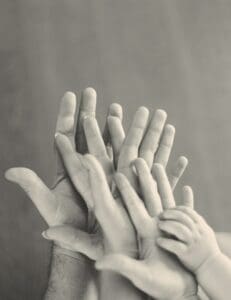By Cassandra West
See original post here.
Clarence Shaffer’s financial situation is a mirror of the times, rising and falling as the economy fluctuates.
When he was born, the poverty rate was 19.5%, so alarmingly high that the U.S. president at the time, Lyndon Johnson, declared a “war on poverty” in his 1964 State of the Union speech. By 1973, the rate had fallen to 11.1%, then rose to 15.1% in 2010, before dropping to 11.5% in 2022. The numbers reflect how precarious personal finances can be, as Shaffer knows.
Born in Chicago, Shaffer, 60, lived for years in California and had good-paying jobs in the Los Angeles area as a security manager for the Academy Awards and as a computer analyst for Fox Television and Sony Pictures. Today, he’s back in suburban Cook County working as a security contractor while being the primary caretaker for his 88-year-old mother. Because his work is unstable, so is his income.
“My job is whenever they call, so it’s not very often that I’m working,” Shaffer says. “It’s either feast or famine in my business, and mostly famine.”
The “famine” led him to apply last December for the Cook County Promise Guaranteed Income Pilot program, created to provide economic stability, opportunity and security to low-income households. Funded by the American Rescue Plan Act, or ARPA, the $42.5 million pilot is the biggest publicly funded guaranteed income pilot in the country, county officials said at the time. More than 230,000 applications came from county residents hoping to get the unconditional $500 monthly cash payments over two years. Shaffer submitted his application on the last day and made the cut.
Getting the $500 a month “keeps you from worrying, since you know that money is coming in every month,” Shaffer says. He uses the money for life and health insurance payments. “My job doesn’t offer that. They do, but it’s at a more costly fee.” So when work is slow and his paycheck is less, the $500 helps him make the payments and not lose his coverage.
The “war on poverty” turns 60 next month, but it never actually ended. Poverty is too persistent. But the declaration led to safety net programs like the Supplemental Nutrition Assistance Program, or SNAP, formerly known as food stamps; Medicare; Medicaid; the Head Start program and expanded Social Security. Now with guaranteed income pilots being introduced by Cook County, the city of Chicago and a host of municipalities around the country, another anti-poverty policy iteration promises a measure of financial stability for low-to-moderate-income households.
Poverty interventions
With a poverty rate of 16.9%, the city of Chicago under Mayor Brandon Johnson is addressing economic security in less direct-cash ways: by eliminating the subminimum wage for tipped workers, passing a new paid leave policy (though it faces amendments), pushing for a hike on the real estate transfer tax to fight homelessness and exploring a municipally owned grocery store.
“There are interventions that are required at the household level to stabilize people and families,” says Ameya Pawar, a former City Council member who is a senior adviser with the Economic Security Project, an economic empowerment advocacy organization. It assisted Cook County with its Promise Guaranteed Income Pilot and is a strategic partner with the Johnson administration on the public option grocery store.
Pawar, who earned a master’s degree in social work from the University of Chicago, says he learned in his first year “that people who are living in concentrated poverty are not just experiencing it at a household level. They are also experiencing what’s happening around them. And what makes Chicago unique and, obviously, well documented is that you have communities that have been for generations excluded from participating fully in the economy.”
Former Mayor Lori Lightfoot and city Department of Family & Support Services Commissioner Brandie Knazze in April 2022 launched the city’s yearlong Chicago Resilient Communities Pilot). The $31.5 million guaranteed income program funded by ARPA dollars was designed to improve the financial stability, health and well-being of Chicago residents living in poverty. It ended in June 2023, after providing 5,000 Chicagoans 12 monthly payments of $500 with no strings attached.
Johnson says he’s committed to expanding the program. During a budget briefing in October with Crain’s editorial board, city Budget Director Annette Guzman said the administration is “looking to see where there is funding that could be shifted into” a guaranteed income program. “It is another way that we’ll be working to help those who are unhoused or who are finding it difficult to stay in the city of Chicago because of how high our rents are.”
The Johnson administration did not respond to a request asking when it expects to announce reauthorizing a guaranteed income program.
“It’s not insignificant that you have two (guaranteed income) pilots happening in the third-largest city and the second most populous county in the United States,” says Audra Wilson, president and CEO of the Shriver Center on Poverty Law. “We see how families are using this money. This is one of many efforts to continue to support families that are living in poverty.”
Poverty incomes
The Census Bureau poverty definition uses a set of income thresholds that vary by family size and composition to determine who is in poverty. If a family’s total income is less than the family’s threshold, then that family and every individual in it is considered in poverty.
The Inclusive Economy Lab at the University of Chicago Harris School of Public Policy will issue initial findings from the city pilot a year from now and from the county pilot a year after that. “Chicago and Cook County are where the boldest experiments are happening” when it comes to guaranteed basic income, says Carmelo Barbaro, the lab’s executive director. “Cook County is the largest by dollar amount and the city’s is largest in terms of the number of participants and ultimately the place where the rest of the country tries to learn from.”
Cook County Board President Toni Preckwinkle said during an October meeting with Crain’s that the county is committed to making its guaranteed income program permanent. One of the ways to fund it is out of the Cook County Equity Fund, she said. Her administration established the fund in 2020 to address institutional and structural barriers to racial equity. Preckwinkle has made racial equity, and with it, closing the wealth gap, a centerpiece of her administration.
“When I got this job, I started doing some research on regional economic growth,” she told Crain’s. “What I learned is that those regions that have the least inequality are the most economically vibrant, and one of the drags on economic growth in this region is tremendous inequality.”
Earlier in the year, Preckwinkle became co-chair of a coalition of elected leaders, Counties for a Guaranteed Income, that advocates for programs that provide no-strings-attached cash payments to people in need. Mayors for a Guaranteed Income launched in 2020. Evanston Mayor Daniel Biss is a member; Mayor Johnson is not listed on the website.
The city of Evanston and Northwestern University joined the growing guaranteed basic income, or GBI, movement in December 2022, dispensing $500 monthly to 150 individuals for one year. Northwestern provided $400,000 in funding for the pilot program. Additional funds came from ARPA, the city of Evanston and the Evanston Community Foundation.
Even historically less progressive cities like Birmingham, Ala., and Columbia, S.C., have launched pilots, The Washington Post reported.
Old idea made new
The idea of a guaranteed income isn’t a pandemic-inspired invention. It goes back to the founding of the United States. In 1776, Thomas Paine proposed a type of basic income in his pamphlet, “Common Sense.” In 1966, the Black Panthers’ Ten-Point Program called for the government “to give every man employment or a guaranteed income.” Today, the U.S. has nearly 100 GBI demonstration pilots, according to the Arlington Community Foundation in Virginia. More are in the works.
All aren’t government funded or sponsored. In 2019, former Mayor Michael Tubbs founded the Stockton Economic Empowerment Demonstration in Stockton, Calif. Funding came from donors, and it became one of the country’s most high-profile guaranteed income experiments, giving 125 randomly selected residents $500 per month for two years with no strings attached. Participants’ job status, financial stability and overall well-being improved, according to a study of the program.
Falling short
Across Illinois, for all household sizes and in all locations, the Federal Poverty Level is well below the ALICE Household Survival Budget, which is the estimated cost of the essentials needed to live and work in the modern economy. A family of four saw that budget jump 10% in 2021 vs 2019 while the federal poverty level only increased by 3%.
Richard Wallace, founder of Equity and Transformation, or EAT, a Chicago nonprofit, knew of the results in Stockton and thought his organization could do its own version. EAT launched the Chicago Future Fund guaranteed income program in 2021 for formerly incarcerated residents of West Garfield Park. The program provided $500 for 18 months to 30 participants who were 18-35 years old and earned less than $12,000 per year. EAT spent a year and a half fundraising to get its experiment off the ground.
“It was an opportunity to advance a model around addressing issues like income volatility, psychological wellness, physical functioning and recidivism in Black communities,” Wallace says.
Why West Garfield Park? The West Side neighborhood has been historically impacted by redlining and contract selling, has a population that is 93% Black and a per capita income of $11,739. It’s also home to the demographic with the highest unemployment and homicide rates in Chicago, Wallace says. “There’s a direct correlation between joblessness and homicides. We’re going to begin to wrestle with these facts in an effort to bring about an equitable Chicago, a safer Chicago. How long can we leave the folks who are in need outside of the safety net simply because of their background?”
Guaranteed income programs won’t make everyone who participates whole, proponents agree, while critics say the programs disincentive people to work. Stockton participants reported increased financial independence and self-sufficiency and improved health, according to the Journal of Urban Health. In most cases, GBI recipients have jobs, albeit, low-paying ones.
“There’s a pilot program called (Cook County) Promise that’s been giving thousands of low-to- moderate-income families $500 in cash every month to help them meet basic needs,” former President Barack Obama said during the Obama Foundation’s 2023 Democracy Forum in November. “The thesis is that you improve financial stability,” he said. “You improve the well-being of low-income families. They actually can fix a busted car. They don’t have electricity turned off. Their lives are more stable. It doesn’t discourage them from working full time. It, in fact, makes it easier for them to go out and find a job. And work full time.”
LaTanya Jackson Wilson, vice president of advocacy for the Shriver Center on Poverty Law, says public assistance disincentivizes people to save money, a policy that keeps people mired in poverty. “When people are on public assistance, they’re limited to the amount of money they can save,” she says. Even when inheriting a house that’s not worth a lot, for example, a person on government assistance would have to give it up or lose their benefits.
GBI advocates say that today’s economy is unjust and often precarious. Guaranteed income isn’t enough to live on, but it can make recipients less vulnerable.
“During the pandemic, we passed policies that would have started to level the wealth inequality in America,” says Natalie Foster, president and co-founder of the Economic Security Project. “We passed the Child Tax Credit, which sent a check to every parent in America with no strings attached. We sent stimulus checks to so many families across America. There is precedent now for what it looks like to guarantee economic security in America,” Foster says. “We know we can do it. So now the challenge is how we amass the political will to do it again.”
Poverty rates in big U.S. cities
Of the nation’s cities with populations above 1 million, Chicago has the sixth-highest poverty rate.
The Economic Security Project is urging states to adopt and expand child tax credits. Earlier this year, two Illinois lawmakers introduced legislation to offer a $700 credit per child that would be phased out for single taxpayers earning more than $50,000 annually and joint filers earning more than $75,000.
In 2021, the temporary federal Child Tax Credit in the American Rescue Plan was the largest child tax credit ever, providing monthly payments of $250 or $300 per child without having to take any action. Child poverty rates dropped from 9.7% to 5.2%. But after those payments ended in the second half of 2021, the rate skyrocketed to 12.4%.
The Center for Tax & Budget Accountability says, the federal Earned Income Tax Credit “has become one of the more effective anti-poverty programs in the United States.” For every $1 a state spends on refundable tax credits, like the EITC or CTC, that amounts to $2.52 in local economic activity.
Many families who were financially struggling and experienced the benefits of tax credits now find themselves back where they were pre-pandemic, Wilson, of the Shriver Center on Poverty Law, says. “Actually, it’s worse than where we were pre-pandemic because what has changed is inflation. . . .Everything else has actually gone up, so to be back where we were means that people are faring worse.”
Wilson acknowledges other measures that are being enacted to help families who are “continually on this hamster wheel” of trying to keep up with everyday obligations. “It’s great that you have a minimum wage that is rising, great that you’ve eliminated the subminimum wage, but people complain that (they) don’t feel it because everything else is still a pressure on (them).”
Wilson wishes more would appreciate the interdependence of government, businesses and workers. “The city of Chicago is having a lot of challenges now under a new administration. You’re talking about a foreclosure rate of commercial properties that has grown exponentially,” she says.
As buildings hollow out and remote work brings fewer people downtown, workers in industries like tourism and hospitality are feeling the pinch. They no longer have the base they once had through hospitality and restaurants, an irony that compounds the problem, Wilson says. “No matter what you do to help the individual, if you’re not looking at the entirety of the circumstances that keep people constrained and mired in poverty, then we’re going to feel like we’re always having this conversation.”




















